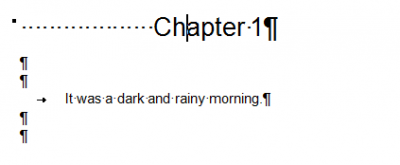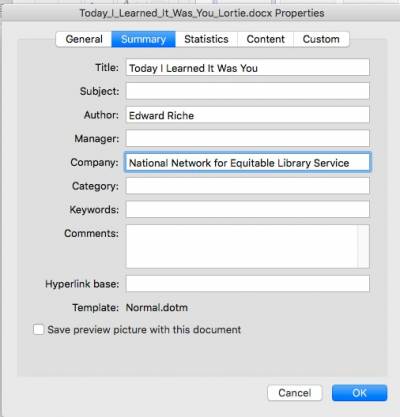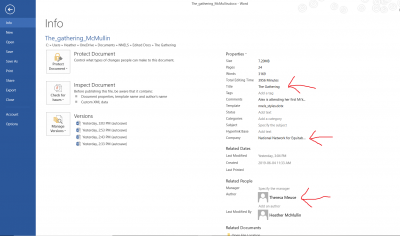Setting up MS Word for Reformatting E-Text
In this section you will learn how to set up MS Word. It is important to follow these steps for each book you reformat.
Step One: Set Document Properties
Before you start editing, set up your document properties. Add the title, author, and other information (below). This data will become the book's metadata and is used by assistive technology.
- Go to
Filein the top menu - Select
Properties - Enter the
Titleand theAuthorof the work- If the book has multiple authors, separate their names with a comma
- Enter the
National Network for Equitable Library Servicein theCompanyfield. Do not use the publisher name of the original book.
Here is a video demo on How to Set up the Document Priorities in Word for NNELS
Note: do not use underscores (_) in document properties.
See also document metadata.
NOTE: if you are working in Office 2013, follow these instructions for setting the document properties:
- Click the 'File' tab.
- You should now be on a page titled 'Info'. Click on the link 'Show All Properties'.
- If needed, edit the author and title. Change the company to National Network for Equitable Library Service.
- Press the back arrow to return to the document.
Step Two: Set Work Area
Do the following steps for each book you reformat:
View>Print Layout- Show
Navigation Pane: (Windows Mac:View>Navigation Pane) This is a ‘map’ of the structure in terms of the heading styles that been applied in the document. The map provides a quick means of navigating to different headings. - Show all non-printing characters: (Windows:
Ctrl+Shift+8. Mac:Cmd+8) This shows formatting characters and marks in the document. There are a few non-printing characters and marks that Word uses (spaces, tab characters, paragraph or ‘carriage return’ characters, and object anchors) that do not show up on the printed page. It can be useful to make them visible while editing. - Show
Style Pane: The Styles Pane is useful for seeing what styles have been applied to text, picking styles to apply to text, and managing styles. Style-formatting is a necessary part of making documents accessible. - Show
Ruler: The Ruler will help you check to see that all body text and images are left justified. Here is a link to directions on how to set up your ruler. Quotes and Headings do not need to be left justified only the body text of the document. You can use direct formatting buttons toAlign LeftandDecrease Indentto fix justification.
Here is a tutorial on how to Set Up MS Word
.rtf file, contact the Production Coordinator through RT and they will convert the file for you to .docx
Step Three: Clear Formatting
Once you have Word set up properly you will be able to begin reformatting the document.
The first step is to clear all formatting in the document:
- Make sure the
Style Paneis open - Select all of the text
COMMAND+Afor MacCTRL+Afor Windows PC
- Select the
clear formattingbutton located at the top of theApply a Stylebox in theStyle Pane
Here is a quick video for Clearing Formatting
Now you can start applying styles as needed. See the Styles & Headings section for more info applying styles and the importance of headings.
Each section of a standard book is formatted as per the wiki instructions. The Books Sections of the eText wiki show you how, and is divided by the sections found in most books.
The rest of the wiki is divided up for your convenience. If anything is missing, or unclear, post a question in the Q&A section!
After you have finished reformatting the book you will need to pass the ticket to the Production Coordinator, and upload the finished book to CyberDuck.
- TAB characters used to provide indentation
- Multiple Paragraph ‘Return’ characters (¶) used to provide spacing between paragraphs
- Newline breaks (↵)
- Multiple SPACE characters
If any of this exists in the document, then it is not properly formatted with styles. You will need to remove these spaces. See Find & Replace for more instructions.



